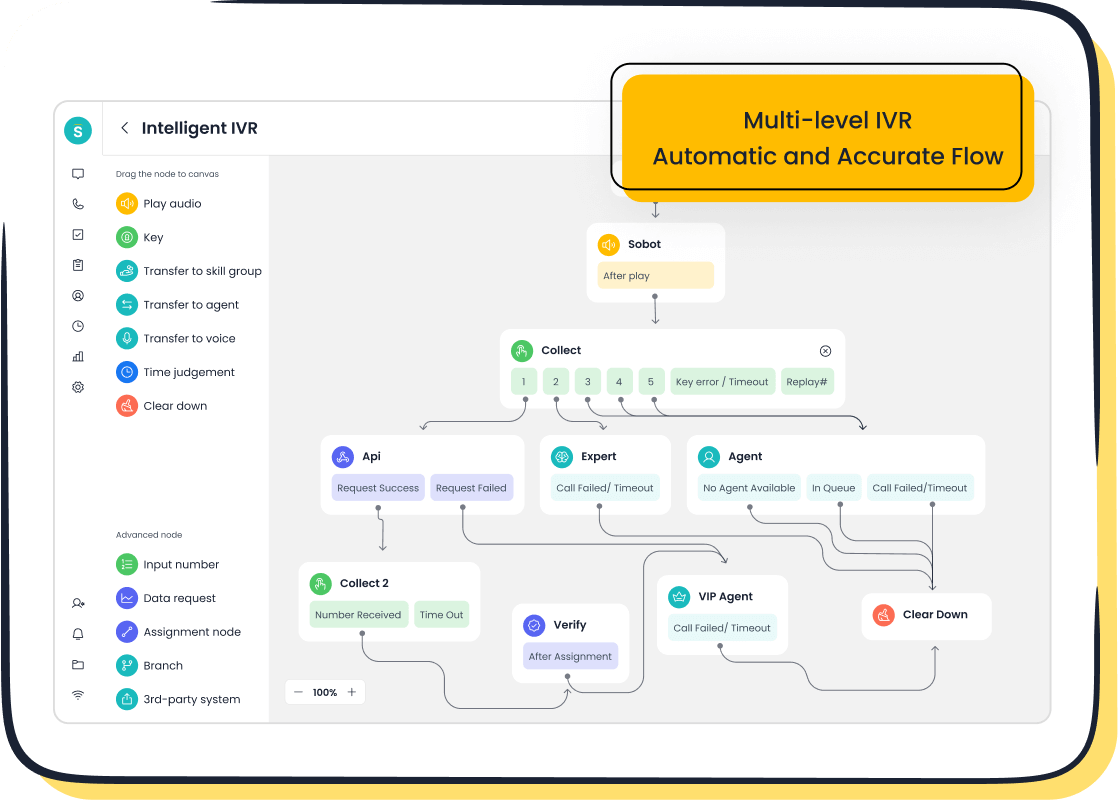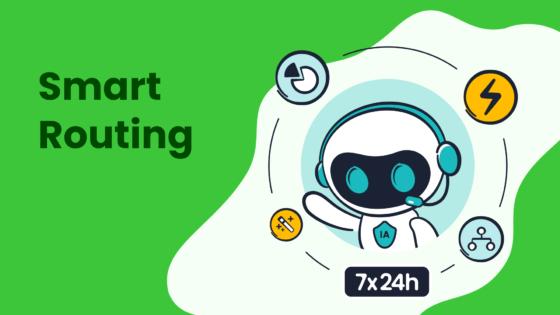What are the Main Capabilities of ACD in Call Centers

What is acd in a call center? ACD, or automatic call distribution, is a smart system that directs incoming calls to the most suitable agents in a call center. This technology helps reduce wait times, boosts first-call resolution, and connects customers to the right support quickly. Key features of acd include intelligent call routing, skills-based assignment, call queuing, and real-time analytics. Sobot call center uses these features to improve customer service by lowering call abandonment rates and ensuring agents handle calls that match their expertise. With Sobot AI, call centers see better workload balance, higher customer satisfaction, and a smoother customer experience.
What is ACD in a Call Center

Definition of Automatic Call Distribution
Automatic call distribution, often called ACD, is a technology that helps call centers manage large numbers of inbound calls. When customers contact a call center, the automatic call distributor receives each inbound call and quickly decides where to send it. The system uses caller information, agent skills, and availability to make the best match. For example, if a customer needs help in a specific language, the ACD can route the call to an agent who speaks that language. This process improves customer satisfaction because callers reach the right person faster.
ACD systems use several call distribution methods. Some common strategies include fixed order, round robin, idle time based, and skills based. Each method helps balance workloads and ensures that no agent gets overwhelmed. The automatic call distributor also works with other call center systems, such as IVR, which collects caller data before routing. This teamwork between systems makes the call center more efficient and responsive.
Core Functions in Call Centers
The automatic call distributor performs many essential features in modern call centers. These functions help improve both customer experience and agent productivity. Some of the main tasks include:
- Caller identification using caller ID, location, or call history.
- Skill-based routing that matches inbound calls to agents with the right expertise.
- Checking agent availability and capacity to avoid overload.
- Managing multiple inbound call queues and setting priorities.
- Integrating with IVR and CRM systems for smarter routing.
- Real-time monitoring and analytics for performance tracking.
- Handling overflow by sending calls to backup agents or self-service options.
These features allow call centers to reduce wait times and balance workloads. Sobot’s call center platform uses advanced ACD technology to support global businesses. For example, Sobot’s system can handle millions of inbound calls daily, offering stable service with a 99.99% uptime. This level of reliability helps companies like Weee! deliver fast and accurate support to their customers. By using a strong call distribution strategy, call centers can optimize their operations and provide better service.
Key Features of ACD Systems
Automatic call distribution, or ACD, brings many essential features to the modern call center. These features help manage inbound customer calls, improve agent productivity, and create a better customer experience. The most important routing features include intelligent call routing, skills-based and priority routing, and call queuing and management. Each of these advanced routing features plays a unique role in making call routing systems more effective.
Intelligent Call Routing
Intelligent call routing stands at the heart of every successful call center. This feature uses data and smart algorithms to direct inbound calls to the best available agent. The system looks at caller information, agent skills, and real-time data to make quick decisions. For example, if a customer calls with a billing question, the system sends the call to an agent who knows about billing. This process helps reduce average call handling time and increases first call resolution rates.
Many leading companies use intelligent routing to improve their service. Verizon uses AI to predict customer intent about 80% of the time, which helps route calls faster and reduces the number of transfers. American Express connects customers directly to the right team, making sure issues get solved on the first call. These real-world examples show how intelligent routing features can boost customer satisfaction and loyalty.

Sobot’s Voice/Call Center uses intelligent call routing to match inbound calls with the right agents. The platform uses real-time analytics and CRM integration to optimize call distribution. This approach helps reduce wait times and ensures that customers reach the right person quickly. Sobot’s system also supports automatic number identification and dialer number identification service, which speeds up the routing process and lowers unnecessary transfers.
Tip: Intelligent call routing not only improves customer experience but also helps agents stay productive by balancing workloads and preventing burnout.
Skill-Based and Priority Routing
Skills-based routing is one of the most essential features in any advanced call routing system. This feature matches inbound calls to agents based on their specific skills, such as language, technical knowledge, or product expertise. The system checks agent availability, language, and qualifications before connecting the call. This process ensures that customers get the help they need from someone who understands their problem.
Priority routing adds another layer to the process. The system can prioritize calls from VIP customers, urgent issues, or high-value sales leads. This call prioritization ensures that important calls get answered first, improving responsiveness and customer satisfaction.
Here is a simple table showing how leading ACD systems use these routing features:
| Routing Feature | Benefit |
|---|---|
| Skills-based routing | Matches calls to agents with the right skills |
| Priority routing | Answers urgent or VIP calls faster |
| Real-time analytics | Tracks performance and adjusts routing |
| CRM integration | Personalizes service with customer data |
Call centers set up skills-based and priority routing by following a few steps:
- Callers use an IVR menu to state their issue.
- The system matches the input with agent skills and availability.
- The most suitable agent gets the call.
- The system records and analyzes call data to improve future routing.
Sobot’s Voice/Call Center makes it easy to set up these advanced routing features. The platform allows managers to define agent skills, set priorities, and adjust routing rules with a drag-and-drop interface. This flexibility helps call centers respond quickly to changing business needs.
Note: Skills-based routing reduces unnecessary call transfers and wait times, which leads to higher first call resolution and better agent morale.
Call Queuing and Management
Call queuing and management are critical routing features in every call center. When all agents are busy, the system places inbound calls in a queue. The system manages these queues by setting priorities, offering callback options, and providing wait time information. These features help reduce call abandonment rates and keep customers informed.
Long wait times and confusing IVR menus can frustrate callers and increase abandonment. Modern call routing systems solve this by offering clear menu options, callback features, and transparent wait time updates. For example, Sobot’s Voice/Call Center provides interactive voice response menus that collect caller information and route calls efficiently. The system also offers callback options, so customers do not have to wait on hold.
Call queuing strategies play a big role in customer satisfaction. By using predictive dialing and skill-based routing, the system matches agent availability with call volume. This approach smooths out busy periods and ensures that urgent calls get answered quickly. Sobot’s platform also supports real-time monitoring and analytics, allowing managers to adjust staffing and routing rules as needed.
Customers appreciate clear communication about wait times and the option to receive a callback. These features keep callers engaged and reduce the chance they will hang up.
Key features found in leading ACD systems include:
- Skills-based and priority routing
- Omnichannel routing across voice, chat, and email
- IVR menus for smarter call routing
- Easy integration with CRM and business tools
- Real-time reporting and analytics
- Call queuing with callback options
- Agent desktop with customer data access
- Call monitoring and recording for quality assurance
Sobot’s Voice/Call Center brings all these advanced features together in one platform. The system supports global operations, offers a 99.99% uptime, and integrates with CRM systems for a seamless experience. With Sobot, call centers can handle millions of inbound calls each day, reduce average handle time, and improve first call resolution.
Omnichannel Support in Sobot Call Center
Unified Customer Interactions
Sobot’s omnichannel solution brings all customer conversations into one unified workspace. Agents can see messages from chat, voice, phone, and other channels in a single view. This setup helps the call center reduce unnecessary phone volume and shorten handle times. Customers do not need to repeat their information when switching channels. The system keeps the conversation context, making each interaction smoother and faster. Companies that use unified customer interactions report higher Net Promoter Scores and customer satisfaction. Lower customer effort leads to better retention and loyalty. Employees also feel more engaged and empowered when they can manage all channels together.
Companies focusing on reducing customer effort often see improved customer experience and increased customer lifetime value.
Multichannel Integration
Sobot’s call center platform integrates multiple channels like email, social media, SMS, and web chat. The AI-powered system automates repetitive tasks and provides 24/7 support. This integration allows customers to switch between channels without losing conversation history. Agents can handle more cases efficiently, which boosts productivity by up to 400%. AI-driven workflows let agents focus on complex or sensitive issues. Sentiment analysis tools help agents understand customer emotions and respond with empathy. About 80% of customers who use AI-powered service report positive experiences. Multichannel integration also reduces resolution times and staffing needs.
- Seamless channel-switching keeps the customer experience consistent.
- Real-time insights help agents deliver more personalized service.
Real-World Example: Weee! Customer Story
Weee!, a leading online supermarket, improved its customer service by using Sobot’s omnichannel ACD solution. The company built a strong support team and transformed its operations to focus on customer experience. After switching to Sobot, Weee! saw a big boost in service efficiency and stability. One client reported a 48% increase in customer reception efficiency. The flexible system allowed Weee! to serve a diverse customer base and handle high call volumes with ease. This real-world example shows how Sobot’s omnichannel support leads to improved customer experience and operational success.
Integration and Analytics Features
CRM and Business Tool Integration
Modern call center software connects with many business tools to help agents work smarter. Sobot’s platform offers seamless integration with popular CRM systems like Salesforce, HubSpot, Zoho, and Microsoft Dynamics 365. These integrations allow agents to see customer history, preferences, and past interactions in one place. Agents can use features such as click-to-dial, automated call logging, and call recording access without switching between platforms. This unified view helps agents solve problems faster and provide more personal service.
Common integrations in call distribution software include:
- CRM systems for customer data and case management
- Email marketing and messaging tools
- Helpdesk and ticketing systems
- Billing and invoicing platforms
- Task management and workflow automation tools
- Cloud storage for easy access to files
With Sobot, agents get real-time access to customer records, which reduces hold times and improves first-call resolution. Automation of tasks like call logging and dialing also increases efficiency and accuracy.
Real-Time Monitoring and Reporting
Real-time monitoring is a standard feature in advanced call center software. Supervisors can watch live call activity, track agent performance, and see call queues as they happen. Sobot’s analytics dashboard gives managers instant insights into call volume, wait times, and agent status. This helps leaders make quick decisions to balance workloads and improve service.
Real-time data analysis supports efficient call routing and helps call centers spot trends early.
Reporting tools in Sobot’s system provide detailed summaries of call outcomes, agent productivity, and customer satisfaction. These reports help teams set goals and measure progress.
Data-Driven Performance Improvement
Data-driven tools in call center software help improve key performance indicators (KPIs). Sobot’s analytics features track metrics like automated contact resolution rate, call routing accuracy, and customer satisfaction with automated services. The table below shows how these tools support better results:
| KPI Name | How It Helps the Call Center |
|---|---|
| Automated Contact Resolution Rate | Shows how many issues get solved without an agent |
| Call Routing Accuracy | Measures if calls reach the right agent quickly |
| Customer Satisfaction (CSAT) | Tracks how happy customers are with the service |
Sobot’s data-driven insights allow managers to adjust workflows, train agents, and improve the customer experience. By using these analytics, call centers can boost efficiency and deliver better service every day.
Automation and Self-Service in Sobot ACD

IVR and Voicebot Capabilities
Sobot’s call center platform uses advanced IVR menus and AI-powered voicebots to handle inbound calls efficiently. IVR menus guide customers through options like account balance checks, order status, or payment processing. These menus help customers solve simple problems without waiting for an agent. Sobot’s voicebot uses natural language understanding to answer more complex questions. In many industries, voicebots resolve 70% to 85% of inbound inquiries without human help. For example, a national bank’s voicebot managed to solve 65% of collection cases, cutting costs and improving customer satisfaction. Sobot’s system supports 24/7 AI agents, so customers always get help, even outside business hours.
Automated Callbacks and Self-Service Options
Automated callback features in Sobot’s call center reduce wait times and lower call abandonment rates. Up to 75% of customers prefer a callback instead of waiting on hold. This feature places customers in a virtual queue and calls them back when an agent is free. Callbacks improve first contact resolution and create a calmer experience for both customers and agents. Sobot also offers self-service tools, such as AI chatbots and IVR menus, to answer common inbound questions like password resets or delivery tracking. These options let customers solve problems on their own, which reduces inbound call volume and staffing needs.
Automated callbacks and self-service options help call centers manage high inbound volumes and keep customers satisfied.
Enhancing Efficiency and Customer Satisfaction
Automation and self-service features in Sobot’s ACD system bring many benefits. AI agents and IVR menus handle routine inbound tasks, freeing agents to focus on complex issues. This shift lowers operational costs and reduces agent burnout. Studies show that self-service solutions can cut average handle time by 41% and improve first-contact resolution by 54%. Sobot’s platform also sends proactive notifications and reminders, keeping customers informed. These features lead to improved customer experience and higher satisfaction scores. By using automation, call centers see better efficiency, lower costs, and happier customers.
| Feature Category | Specific Features and Capabilities | Impact / Benefits |
|---|---|---|
| Automation | IVR menus, AI voicebots, callbacks | Faster inbound call handling, reduced costs |
| Self-Service | 24/7 AI agent, chatbots | Improved customer experience, higher satisfaction |
Sobot’s ACD system transforms call center operations with intelligent IVR, AI-powered voicebots, and unified communication channels. The platform automates routine tasks, supports multilingual customer service, and delivers real-time analytics for continuous improvement. Many call centers report faster resolution times, higher agent productivity, and improved customer satisfaction. Sobot’s innovation, flexible integration, and customer-centric design help businesses deliver exceptional customer service and scale with confidence.
- Sobot’s AI handles over 50% of customer interactions instantly.
- The platform reduces agent workload by 60% and supports 24/7 customer service.
Sobot stands out as a trusted choice for any call center seeking efficiency, quality, and a better customer experience.
FAQ
What is ACD in a call center?
ACD in a call center stands for automatic call distribution. This system directs incoming calls to the best available agent. Companies use ACD to reduce wait times and improve customer satisfaction. Sobot’s platform uses ACD to handle millions of calls daily.
How does ACD improve customer experience?
ACD in a call center matches callers with agents who have the right skills. This process helps solve problems faster. For example, Sobot’s ACD system increased Weee!’s customer satisfaction score to 96%. Customers get answers quickly and do not repeat information.
Can ACD in a call center support multiple channels?
Yes, ACD in a call center can manage calls, chats, emails, and social media. Sobot’s omnichannel solution brings all interactions into one workspace. Agents see every message in one place, which helps them respond faster and more accurately.
What analytics does ACD in a call center provide?
ACD in a call center tracks key metrics like call volume, wait times, and agent performance. Sobot’s analytics dashboard gives real-time insights. Managers use this data to improve service and train agents. Accurate reporting helps call centers reach their goals.
Is Sobot’s ACD system easy to integrate with other tools?
Sobot’s ACD in a call center integrates with CRM systems like Salesforce and HubSpot. Agents see customer history and details in one view. This integration saves time and improves first-call resolution. Sobot’s open API makes connecting other business tools simple.
For more details about Sobot’s ACD features, visit Sobot Voice/Call Center.
See Also
Comprehensive Overview Of Quality Assurance Tools For Call Centers
Essential Insights Into AI Software For Call Center Operations
Best Contact Center Technologies Evaluated For The Year 2024
Step-By-Step Guide To Deploy Omnichannel Contact Center Systems
Ways Artificial Intelligence Software Enhances Customer Service Efficiency
